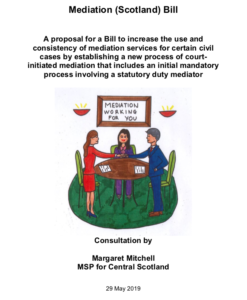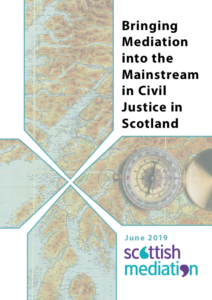

To paraphrase a worldwide cliché, you wait decades for a Mediation Act and two come along at once. On this typically dreich Scottish summer afternoon I find myself in the surprising position of examining two distinct proposals for mediation legislation. Why surprising? This blog has carried news of a succession of mediation acts in countries as diverse as Azerbaijan, Romania, Ukraine, Germany, Singapore, Ireland and Georgia, with its justice minister’s ringing catchphrase “Courts Should Be The Alternative!” However, Scotland’s justice system has been particularly resistant to mediation, its judiciary at times leading a rearguard action to ensure the process remains marginal (see Irvine 2012 “Scotland’s ‘Mixed’ Feelings About Mediation“; Irvine 2010 “The Sound of One Hand Clapping“; Clark 2011 “Lawyers’ Resistance to Mediation: A Scottish Perspective” ). In this blog I consider what Scotland’s Mediation Acts propose, where they overlap and what’s missing. I finish with the £64,000 question: will they achieve what their proponents hope?
Why two?
The reasons are pragmatic – one is speedy(ish), the other longer term. The first (we’ll call it Mediation Act A) is being brought forward by Margaret Mitchell MSP (Member of the Scottish Parliament) as a Member’s Bill (the equivalent of a Private Member’s Bill in Westminster). Ms Mitchell is vexed by “little progress in 15 years” and a Member’s Bill can bypass the need for government support. It has already reached the consultation stage: see Proposed Mediation (Scotland) Bill.
The second (Mediation Act B) is contained in a new report, named with some precision: “Bringing Mediation into the Mainstream in Civil Justice in Scotland.” A specially convened Expert Group, co-chaired by fellow blog writer John Sturrock, produced the report after taking evidence from a range of, well, experts. Number 19 of its 27 recommendations calls for primary legislation to “signal a paradigm cultural shift for dispute resolution in Scotland” (p. 51).
The Expert Group Report is an impressive document, setting out the current situation in Scotland and elsewhere. The same week Scottish Government Social Research published a companion report entitled An International Evidence Review of Mediation in Civil Justice. This indicates government support, and that explains the difference between Scotland’s two proposals. Ms Mitchell’s Member’s Bill is relatively simple, her stated aim being to see a Mediation Act on the statute books before the end of the current Scottish Parliament in May 2021. The Expert Group proposals take a broader sweep, looking to the longer term and, as stated above, “culture shift”.
What’s in them?
Default
Both proposals adopt a default or “nudge” approach (see “Mediation in Scotland: some practical questions and a ‘nudge’ in the right direction“). Here mediation is business as usual while remaining voluntary. If a litigant chooses not to mediate the case trundles on through the court system. The nudge consists in a requirement to consider mediation before making that choice (subject to a range of exceptions – each proposal has its own list).
Mediation Act A: the Mitchell proposal
The details are intriguing. Margaret Mitchell borrows from a couple of sources. From the Netherlands comes the idea of a mediation “self-test questionnaire” (Consultation p. 12). Its aim is to “assist the parties involved, and the mediator, to assess whether the case is suitable for mediation” (p. 14). England & Wales seems to be the source for the “Mediation Information Session” (modelled loosely on the MIAM, Mediation Information and Assessment Meeting, in family law cases). The idea of a duty mediator adapts existing Scottish provision for state-funded duty solicitors in criminal matters.
The litigation journey in civil actions would look like this:
1) The judge issues a self-test questionnaire to the parties
2) The judge appoints a mediator
3) Parties discuss the questionnaire with the mediator in a Mediation Information Session and decide whether to mediate.
4) If they do not wish to mediate they’re free to proceed with the action.
5) If they choose mediation they appoint a mediator and sign a Mediation Commencement Agreement.
6) If the mediation is successful they sign a Mediation Settlement Agreement.
Readers from other jurisdictions will recognise aspects of this approach. One Scottish twist is to propose that steps 1-3 involve no cost to parties, while 5 & 6 are chargeable. This will of course require state funding, a whole additional can of worms. There seems little appetite to increase the current level of legal aid spending (see Legal Aid Review, 2018).
Mediation Act B: the Expert Group proposal
This is a much more thorough document but it seems reasonable to guess the contents of an eventual mediation act from the recommendations. The first two provide a clear statement of intent:
1) A “degree of compulsion” (Expert Group Report, p. 32).
2) A new Early Dispute Resolution Office (EDRO) for all cases in all courts and tribunals (p. 34).
The “nudge” principle is clearly stated at 3) “There should be a presumption that cases will be referred to mediation unless there is a good reason not to do so” (p. 34).
It’s worth unpacking the compulsion element, not least because mandatory mediation is controversial and is specifically ruled out in Mediation Act A. In fact all that’s compelled is attendance at a first meeting where the mediator will “explain what mediation involves, and invite the parties to consider participating” (p. 36). The meeting’s content resembles Mediation Act A’s “Mediation Information Session.” The principal difference lies in timing: the requirement to appoint the mediator first. Presumably this means that if both parties agree to participate there will be nothing to prevent the mediator from continuing on the spot (a model I witnessed in Alberta’s Provincial Court).
Will they work?
There is much more to say about the Expert Group Report and Mediation Act B. To my eyes there are similarities to the approach of Ireland’s Mediation Act 2017 (which took at least 7 years to come to fruition). Having set out the mechanics of each proposal I now turn to their ambitious goal – changing the culture of a justice system. Can this be done via legislation?
The answer is, frustratingly, yes and no. The “no” comes from conversations with mediators in jurisdictions where mediation really is business as usual. It is clear that the biggest single driver of mediation is not legislation but the judiciary. When judges decide to encourage (or even compel) mediation, other justice system operatives, particularly lawyers, take notice. Mediators are found, clients are advised and cases are settled. Some don’t, and they continue through the courts, though typically minds have been focussed and proceedings sharpened by the attempt. Legislation is generally called for during the later, consolidation, phase of mediation’s growth – see for example the US Uniform Mediation Act, adopted in 2001.
The “yes” comes from recent experience here in Scotland. Judges may have little time for mediation but they respect rules. When the new Simple Procedure came into force in 2016 mediation remained a minority pursuit. However, for the first time these rules required judges to ensure that ADR was considered. Within a short space of time our Mediation Clinic here in Glasgow saw a trebling of cases. We also spoke to judges who had overcome initial scepticism based on results. At the lower-value level we encountered very little of the resistance I mentioned above.
And so my hunch is that Mediation Act A, then Mediation Act B, or some combination of both, will make a difference by this simple logic:
1) legislation encourages/influences judges
2) judges encourage/influence the legal profession
3) the legal profession encourages/influences its clients
4) clients generally like mediation better after they’ve attempted it (with some exceptions) particularly if it leads to a resolution they can live with at reasonable cost
5) the system adapts to the new reality.
Of course there’s much more to it than this. Space has not permitted discussion of other key aspects of mediation legislation – confidentiality, status of agreements, standards for mediators, court rules – not to mention cost. Having said that, I welcome Scotland’s two new Mediation Acts. A huge amount of work has gone into both proposals. They deserve to be passed, and for the next steps we look to the fascinating world of politics. And good luck with that!
________________________
To make sure you do not miss out on regular updates from the Kluwer Mediation Blog, please subscribe here.


